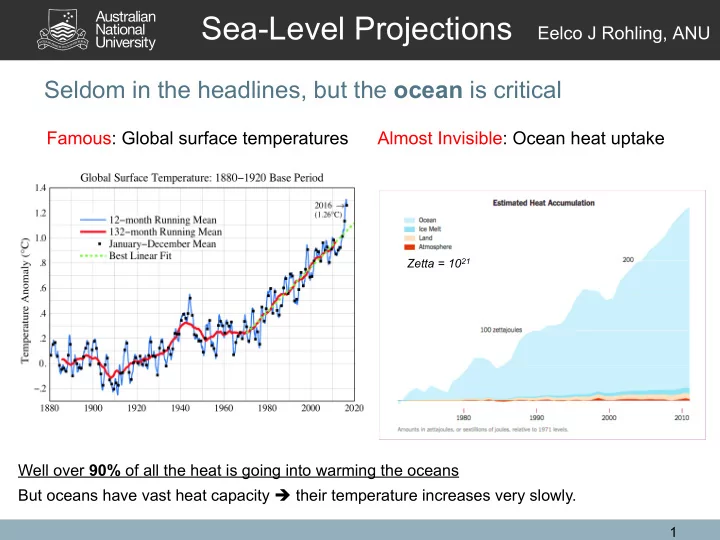

Sea-Level Projections Eelco J Rohling, ANU Seldom in the headlines, but the ocean is critical Famous: Global surface temperatures Almost Invisible: Ocean heat uptake Zetta = 10 21 Well over 90% of all the heat is going into warming the oceans But oceans have vast heat capacity è their temperature increases very slowly. 1
Eelco J Rohling, ANU Sea-level change Main influences: 1 – Warming of the water “Thermal expansion of water”: +0.4 m for every 1 °C temperature rise over the entire ocean depth of 3.7 km. 2 – Melting of land ice, and melt/icebergs entering the seas Addition of water to the oceans ‘fills them up’ more. - Mountain glacier melt – at most about 40 cm sea-level rise if all disappear (~ by 2100) - Continental ice sheets – Max. inputs: Greenland 7 m; East Antarctica 53 m; West Antarctica 5 m 2
Eelco J Rohling, ANU Sea-level change Greenland: If linear, 0.7 cm in 10 years = 7 cm per century. BUT: rate of loss is increasing, so will be (much) more. Antarctica: If linear, 0.35 cm in 10 years = 3.5 cm per century. BUT: rate of loss is increasing. 3
Eelco J Rohling, ANU Existing sea-level projections for 2100 CMIP-5 = IPCC AR5 ObsHist = fully constrained by historical observations Only processes included that have acted in historical times. Any new/additional processes will increase estimates. Goodwin et al., Earth’s Future , 2017 4
Eelco J Rohling, ANU Impacts Factor of increase of extreme (>99 th percentile) sea-level events 10,000x means that a current once-a-century flooding level is reached every time at normal high tide Goodwin et al., Earth’s Future , 2017 5
Eelco J Rohling, ANU New work includes unprecedented processes http://www.bitsofscience.org/wordpress-3.0.1/ wordpress/images/2016/09/greenland-ice-sheet- melting-feedbacks.jpg DeConto & Pollard, Nature, 2016 https://nsidc.org/sites/ nsidc.org/files/images/ iceshelf_locations.png http:// www.scientia.global/ wp-content/uploads/ 2017/05/page-3- image-1.jpg 6
Eelco J Rohling, ANU First projections including unprecedented processes … — = business as usual pathway old maximum NOAA Technical Report NOS CO-OPS 083, 2017 7
Recommend
More recommend